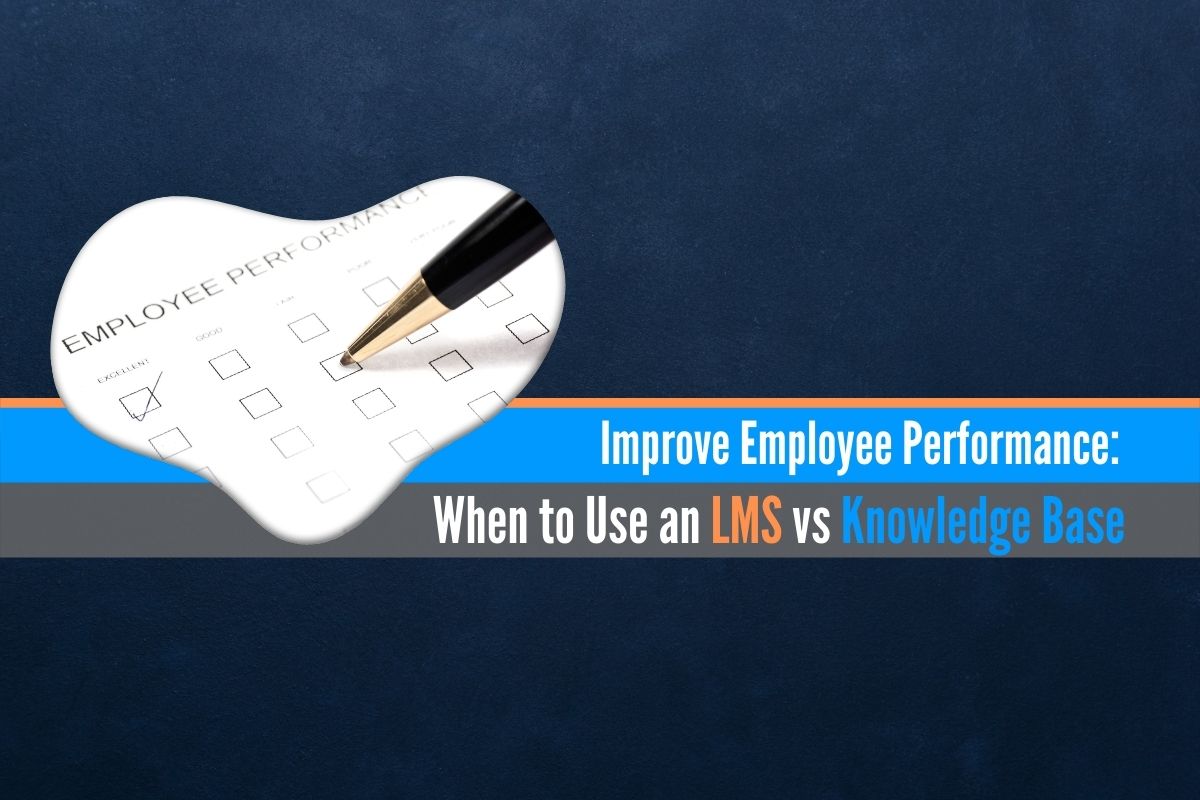Improve Employee Performance: When to Use an LMS vs Knowledge Base
What is impacting employee performance?
Do you know why your employees aren’t performing well? Consider:
- Can they access your supporting documents such as procedures and job aids?
- Are they forgetting their training?
- Are they not understanding the big picture and connecting the dots?
- Are they struggling with critical thinking skills?
If you don’t know what the specific issue is, then buying new software will be like buying a blender to peel potatoes. It’s not going to do much good.
Before you purchase any new software, figure out the answer to the question: why are employees not performing? As you discover what is interrupting your employees’ ability to perform at their peak, you can directly address the issue (without wasting time or resources).
2 options to help improve employee performance
A knowledge base and an LMS solve two different problems: training automation and performance. Let me explain the role of each software platform in improving employee performance.
1. Learning management system (LMS)
An LMS is a powerful training tool that provides e-learning, self-led courses, interactive activities, quizzes, and more.
Using an LMS, you can teach employees about new concepts, new skills, and continue to build on the knowledge and skills that you taught elsewhere (classroom or e-learning).
There are a lot of perks to using an LMS for your training:
- Employees can take courses at a time that is convenient for them.
- It can provide completion reports, which are critical for compliance (e.g. ethics, security awareness)
- It is more economical for helping employees learn new concepts and understand big picture ideas
- Employees can practice specific skills
- You can purchase courses for your employees
- You can provide materials that help employees connect the dots in what they’re doing every day
In a nutshell, what an LMS most helps companies do is automate their training processes — especially for larger companies. It makes it easier for them to scale training activities and check off the box for any topic they have to teach all employees.
If you need to get more organized in training or need to show compliance in your training, an LMS would work. An LMS can also help with performance, but less directly.
Using an LMS, you can train your employees on background information. They can review processes, which can help them see things they missed in initial onboarding or pick up on new tactics.
🔍 Related: Knowledge Base vs LMS: What Are Their Roles? How Do They Differ?
2. Knowledge base
It’s highly likely that you already have some form of knowledge base or document management file. Some common simple knowledge bases we see businesses using include SharePoint, Google Drive, and other document libraries.
The purpose of a knowledge base is to create, store, and share information across your company. It provides your company with a single source of truth. It’s where employees can turn to for support when they have a question.
A knowledge base is used to help with employee performance in the moment they need it. It has a direct impact on the day-to-day performance of an employee.
If employees are asking a lot of questions like — “How do I do this?” or “Can we do this?” — then you don’t need an LMS. All you need is a knowledge base. Employees just need a place to go that has answers, step-by-step procedures, reference tables, etc.
Also, if you notice a lot of operational mistakes being made by employees like doing procedures incorrectly, then you don’t need an LMS. Again, you just need a resource that your employees can use while they are in the workflow.
Tip: If you already have a knowledge base or document library and employees are still making operational mistakes, investigate why. Are your directions unclear? Can your employees find the guides? Are your employees even using your knowledge base?
You may just need to make some edits, reiterate using your knowledge base articles, or some other simpler fix. If your employees aren’t using your knowledge base, you may consider switching to a different knowledge base that employees would rely on.
Putting it into perspective: A comparison analogy
Think of it as learning how to cook. If you were learning how to cook, an LMS and knowledge base would play a different role in your training.
An LMS would help a new cook understand what baking is, important things to consider (like opening up an oven during the middle of a bake is a no-no), how ingredients interact with each other, and specific skills like whisking or separating eggs.

These are skills and knowledge we take for granted, but a new cook needs to be taught this background information before following a recipe.
The knowledge base stores the actual recipes. You don’t expect cooks to memorize all of the recipes and ingredients — you just need them to be able to follow them.
So, if you have a bunch of “cooks” who understand the basics, then an LMS probably isn’t necessary. You just need a better way to write “recipes” and an easier way for “cooks” to find them and use them while “in the kitchen.”
But if you are bringing on a lot of employees who don’t know the basics of cooking and you want to automate the delivery of the learning material, then an LMS AND a knowledge base would be helpful.
Want to improve performance with a knowledge base?
If you are focused on improving employee training and performance, there are many software solutions available. It’s important to understand the exact struggle so that you can choose software that directly improves the pain points.
ScreenSteps helps employees make fewer mistakes because it is easy to follow a guide while in the workflow. With a ScreenSteps knowledge base, employees can easily search and find your articles in your knowledge base. Then they can immediately apply them while performing the task.
If you are considering using a knowledge base to help improve your employee performance, use these five tips to help you choose the right knowledge base to meet your company’s needs.


.png)

